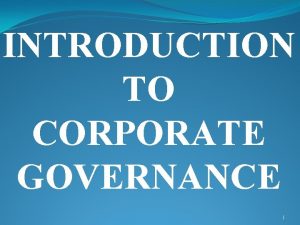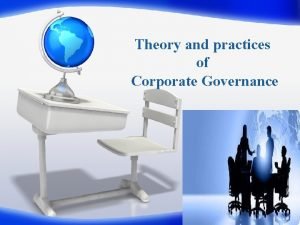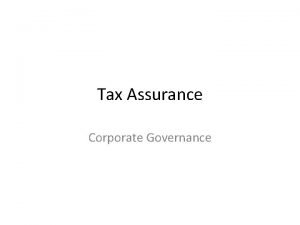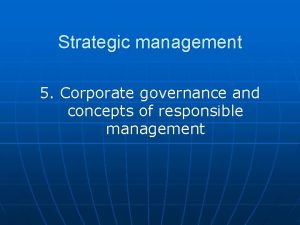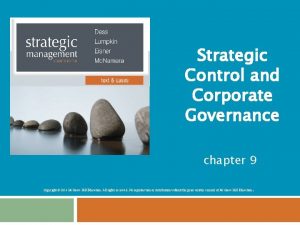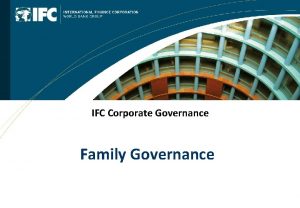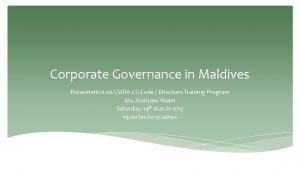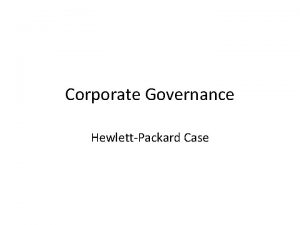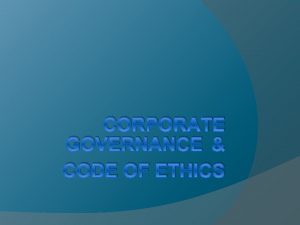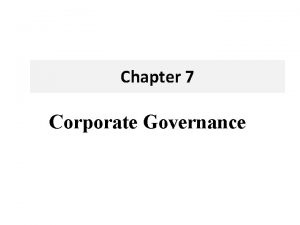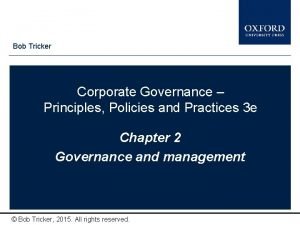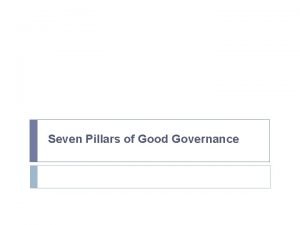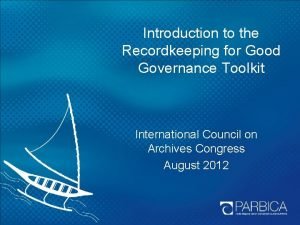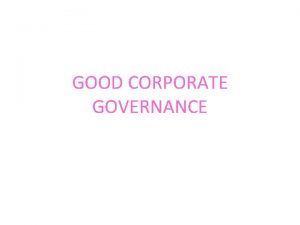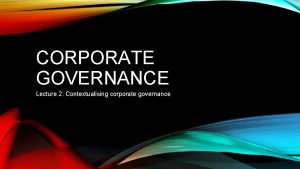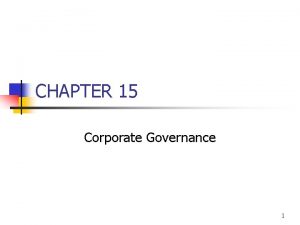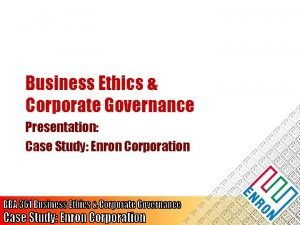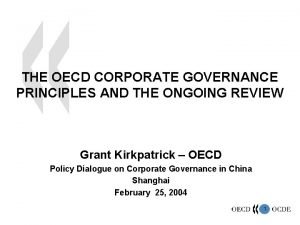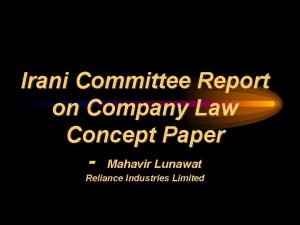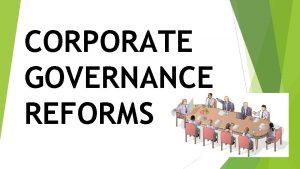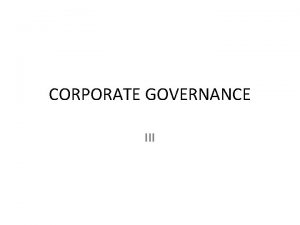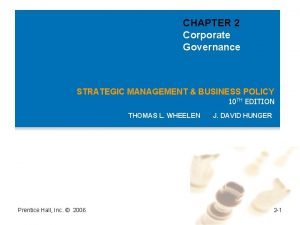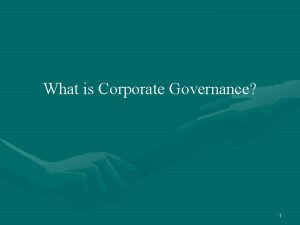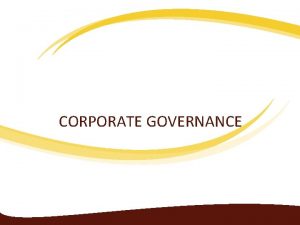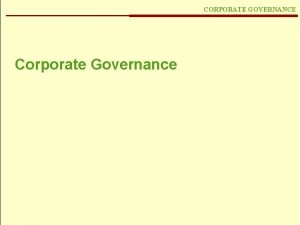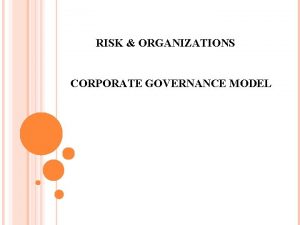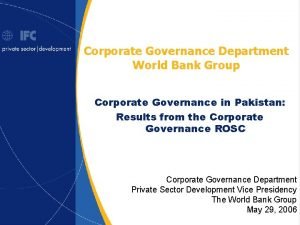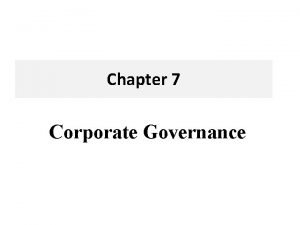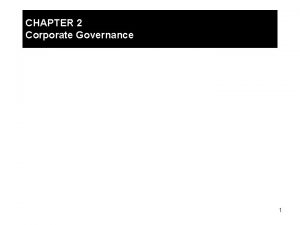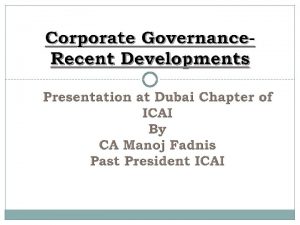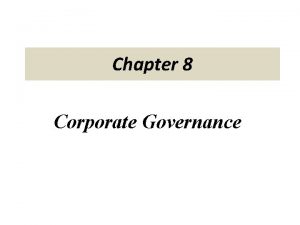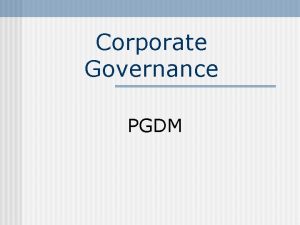Corporate Governance Agenda Introduction What is Corporate Governance







































- Slides: 39

Corporate Governance Agenda • Introduction – What is Corporate Governance? • The OECD principles of Corporate Governance • The Corporate Governance in practice 1

What is Corporate Governance? 2

Corporate Governance – The cornerstone of the modern market-oriented economy 3

Corporate Governance • • • Promote the efficient use of scarce resources Promote the trust of investors Good corporate governance has a positive link to economic development and good corporate performance • Funds will flow to entities which are seen to have internationally accepted standards of corporate governance 4

Corporate Governance • • • Why is it important? Proliferation of financial scandals and crisis Loss of trust of investors Globalization lead to increasing cross-border investment opportunities but investors may not have knowledge about the regulatory framework of overseas investees 5

Corporate Governance • Investors are not willing to invest in countries/companies that are corrupt, prone to fraud, poorly managed and lacking sufficient protection for investors’ rights • Securities and company law protection may help, but not enough • Corporate Governance supplements the legal framework 6

Corporate Governance • Corporate Governance also plays an important role in maintaining corporate integrity and managing the risk of corporate fraud, combating against management misconduct and corruption 7

Corporate Governance - Definition • the system by which business corporations are directed and controlled • specifies the distribution of rights and responsibilities among different participants in the corporation, such as the board, managers, shareholders and other stakeholders • spells out the rules and procedures for making decisions on corporate affairs • provides the structure through which the company objectives are set, and the means of attaining those objectives and monitoring performance (Source: OECD April 1999) 8

The OECD Principles of Corporate Governance 1. 2. 3. 4. 5. 6. Ensuring the basis for an effective corporate governance framework The rights of shareholders and key ownership functions The equitable treatment of shareholders The role of stakeholders in corporate governance Disclosure and transparency The responsibilities of the board - The corporate governance framework should ensure the strategic guidance of the company, the effective monitoring of management by the board, and the board’s accountability to the company and the shareholders. 9

Corporate Governance in practice What do the investors expect? “the Code of Corporate Governance Practices” 10

Board of Directors • Assume responsibility of leadership and control of the corporate • Direct and supervise the corporate’s affairs • Make decisions in the interests of the corporate 11

Board of Directors • • • Regular meetings Active participation Freedom to include items in agenda Sufficient notice for board meetings Access to advice and services of company secretary and independent professional advice 12

Board of Directors • Full record of board/committee minutes, and available for inspection • Independent non-executive directors should be present at board meetings to discuss matter involving conflict of interest • Abstain from voting if conflict of interest exists • Insurance coverage in respect of legal action against directors 13

Chairman and CEO • Segregation of the management of the board and the day-to-day management of the corporate’s business • Balance of power at board level to avoid concentration of power in a single individual 14

Chairman and CEO • Separation of Chairman and CEO • Division of responsibilities between Chairman and CEO clearly laid down in writing 15

Chairman • Provide leadership for the board • Ensure the board works effectively and discharges its responsibilities • Ensure good corporate governance practices and procedures are in place • Ensure all directors are properly briefed on issues arising at board meeting • Responsible for ensuring appropriate information received by directors 16

Chairman • Encourage full and active contribution to the board’s affair • Ensure effective communication between board and the shareholders • Hold annual meetings with non-executive directors • Ensure constructive relationships between executive and non-executive directors 17

Board Composition • Balance of skills and experiences • Balanced composition of executive and nonexecutive directors • Non-executive directors should be of sufficient calibre • Independent non-executive directors should be expressly identified • List of directors updated and their respective role and function identified 18

Appointment, re-election and removal of directors • Formal and transparent procedure for appointment • Succession plan • Re-election at regular intervals • Proper explanation for resignation/removal of directors 19

Appointment, re-election and removal of directors • Specific term for non-executive directors • All directors subject to retirement by rotation at regular interval • Nomination committee formed to make recommendation on appointment of directors and succession planning for directors, chairman and CEO 20

Responsibilities of directors • Keep abreast of the responsibilities as a director • Exercise duties of care, skill, integrity and diligence expected • Ensure proper understanding of the operation, business and the regulatory requirement • Contribute sufficient time and resources to serve the corporate • Attend AGMs to share the views of shareholders 21

Non-executive directors • • • Active participation in board meetings Bring in independent judgment Take lead if conflict of interest arise Serve on committees Monitor the corporate’s performance in achieving pre-set goals 22

Information access by directors Directors should be provided with accurate and appropriate information in order to make informed decision and to discharge their responsibilities 23

Information access by directors • Agenda and board papers should be sent in full in a timely manner to directors • Information supplied must be complete and reliable • Directors should have access to the senior management for information • Information supplied should be of form and quality to facilitate informed decision 24

Remuneration of directors and senior management • Transparency of directors’ remuneration policy • Remuneration should be sufficient but not excessive • Each director not to involve in deciding his/her own remuneration 25

Remuneration Committee • Remuneration committee to be formed, mainly from non-executive directors • Consult Chairman/CEO if needed • Access to professional advice, market comparable information • Make recommendation on policy and structure of remuneration • Determine specific remuneration packages of all executive directors and senior management 26

Remuneration Committee • Review and approve performance-based remuneration • Review and approve compensation arrangement in connection with loss or termination of office, dismissal or removal of directors for misconduct 27

Accountability and Audit – Financial Reporting • Management provide explanation and information to the board to enable them to make informed assessment of financial and other information • The board should present comprehensive assessment of the corporate’s performance, position and prospects in annual and interim reports, pricesensitive announcements and other financial disclosures 28

Accountability and Audit – Internal Control • Ensure the maintenance of sound and effective internal controls to safeguard assets • Conduct regular reviews of the effectiveness of the internal control system, covering financial, operational, compliance and risk management control functions • Prevent fraud, corruption, and malpractices 29

Audit Committee • Have clear terms of reference • A formal and transparent arrangement to apply the financial reporting and internal control principles and maintain appropriate relationship with external auditors 30

Audit Committee • Full minutes of audit committee to be kept • Provided with sufficient resources to discharge its duties • Independent from external auditors 31

Audit Committee • Make recommendation for appointment and removal of external auditors • Monitor the effectiveness of the audit process, ensuring auditor’s independence and objectivity • Monitor the integrity of the financial disclosures • Oversight of the financial reporting and internal control procedures 32

Delegation by the Board • Formal schedule of matters specifically reserved to the board for decision • Clear directions to management as to matters requiring board approval before decision made 33

Delegation by the Board • Clear directions to the delegation of the management and administration functions as well as the powers of management • Review the arrangement for segregation of duties between board and management regularly • Board Committee to be formed, with specific terms of reference, as needed 34

Communication with Shareholders - Effective communication • Maintain on-going dialogue with shareholders and make use of annual general meetings or other general meetings to communicate with shareholders • Transparency in corporate governance practices and business performances through proper and adequate disclosures • Encourage shareholders’ participation 35

Communication with Shareholders - Effective communication • Separate resolution for each separate issue • Chairman of the board and chairman of each board committees be present in general meetings to answer questions at any general meeting • Chairman of independent board committee be present to answer any questions in any general meeting to approve transaction requiring independent shareholders’ approval 36

Communication with Shareholders - Voting by Poll • Inform shareholders about procedure for voting by poll • Ensure proper compliance to regulatory requirement about voting by poll 37

Corporate Governance is a dynamic process and is continually evolving AND It has no boundaries or limits! 38

Thank you! 39
 Objectives of corporate finance
Objectives of corporate finance It means openness a willingness by the company
It means openness a willingness by the company Agenda sistemica y agenda institucional
Agenda sistemica y agenda institucional Sociological theory of corporate governance
Sociological theory of corporate governance Corporate governance definitie
Corporate governance definitie Corporate governance in strategic management
Corporate governance in strategic management Internal governance mechanisms
Internal governance mechanisms Isu dan riset kontemporer corporate governance
Isu dan riset kontemporer corporate governance Family governance definition
Family governance definition Corporate governance in sri lanka
Corporate governance in sri lanka Mbhni hgwpi
Mbhni hgwpi Hp corporate governance
Hp corporate governance P&g corporate governance
P&g corporate governance Corporate governance definition
Corporate governance definition Corporate governance in strategic management
Corporate governance in strategic management Bob tricker corporate governance pdf
Bob tricker corporate governance pdf 4 approaches to corporate governance
4 approaches to corporate governance Seven pillars of good governance
Seven pillars of good governance Corporate governance is a form of
Corporate governance is a form of Corporate governance tool kit
Corporate governance tool kit Corporate social responsibility and good governance
Corporate social responsibility and good governance Latar belakang munculnya gcg
Latar belakang munculnya gcg Corporate governance lecture
Corporate governance lecture Potential problems in corporate governance
Potential problems in corporate governance Chapter 10 corporate governance
Chapter 10 corporate governance Enron scandal presentation
Enron scandal presentation Cadbury report on corporate governance ppt
Cadbury report on corporate governance ppt Oecd corporate governance principles
Oecd corporate governance principles Oecd guidelines on corporate governance
Oecd guidelines on corporate governance Corporate governance definizione
Corporate governance definizione Irani committee report
Irani committee report Kumar mangalam birla committee
Kumar mangalam birla committee Corporate governance clause 49
Corporate governance clause 49 Scope of corporate governance
Scope of corporate governance Corporate governance strategic management
Corporate governance strategic management Insider system of corporate governance
Insider system of corporate governance Global corporate governance forum
Global corporate governance forum What is corporate governance
What is corporate governance Objectives of corporate finance
Objectives of corporate finance Landmarks in emergence of corporate governance
Landmarks in emergence of corporate governance

